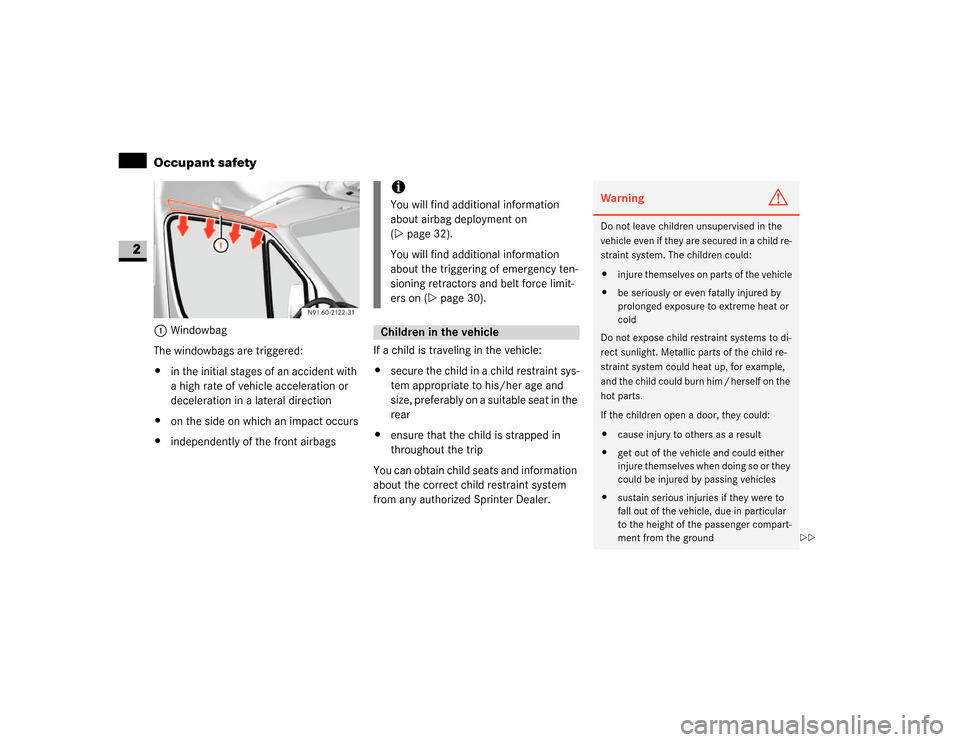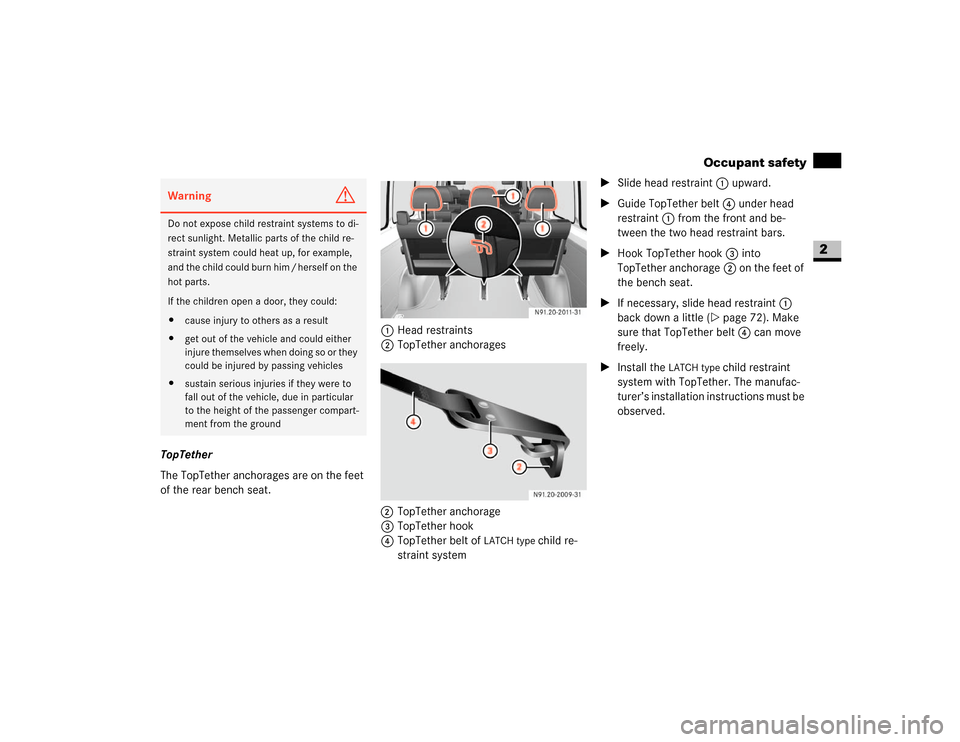2007 DODGE SPRINTER light
[x] Cancel search: lightPage 32 of 393

31 Safety
Occupant safety
2
Warning
G
If the emergency tensioning retractors have
been triggered, have them replaced at a
qualified specialist workshop which has the
necessary specialist knowledge and tools to
carry out the work required.
The manufacturer recommends that you use
an authorized Sprinter Dealer for this pur-
pose. In particular, work relevant to safety
or on safety-related systems must be car-
ried out at a qualified specialist workshop.
Observe the safety regulations when dispos-
ing of emergency tensioning retractors. You
can see a copy of these regulations at any
authorized Sprinter Dealer.
Airbag systemWarning
G
To reduce the risk of serious or fatal injuries
in the event of an accident with a high rate
of deceleration, for example due to an air-
bag inflating within milliseconds, or due to
sudden braking, please observe the follow-
ing points:
\4All vehicle occupants must select a seat
position in which they can wear their
seat belt correctly and which is as far
back from the airbag as possible. The
seat position of the driver must be such
that the vehicle can be driven safely. The
distance from the driver’s seat to the
pedals must be such that the driver can
fully depress the pedals. The distance
between the driver’s chest and the cen-
ter of the airbag cover must be more
than 25 cm. The driver’s arms should be
slightly bent when holding the steering
wheel.
\4Vehicle occupants should wear their
seat belt correctly at all times and lean
back against the backrest, which should
be positioned as upright as possible.
The head restraints should support the
back of the head at about eye level.
\4Move the co-driver’s seat as far to the
rear as possible, especially if a child is
secured in a restraint system installed
on this seat.
\4On vehicles with a co-driver’s airbag, it
is not permitted to secure a rearward-
facing child restraint system to the co-
driver’s seat (\2page 37). Children in a
rearward-facing child restraint system
must be secured on a suitable rear seat.
\4Do not lean forward, for example over
the padded boss of the steering wheel,
especially when the vehicle is in motion.
\4Only hold the steering wheel by the out-
er rim. This allows the airbag to inflate
fully. If you hold the inside of the steer-
ing wheel, you could be injured if the air-
bag were to be triggered.
\2\2
Page 35 of 393

34 SafetyOccupant safety
2
The driver’s front airbag and co-driver’s
front airbag are triggered:
\4in the initial stages of an accident with
a high rate of vehicle acceleration or
deceleration in a longitudinal direction
\4if the system determines that airbag
deployment can offer additional pro-
tection to that provided by the seat belt
\4independently of other airbags in the
vehicle
Thorax sidebags*
The purpose of the thorax/sidebags is to
increase the level of protection for the tho-
rax (but not the head, neck and arms) of
the occupants on the side of the vehicle on
which the impact occurs.
The thorax / sidebags are installed in the
outer sides of the backrests on the driver’s
seat and the co-driver’s individual seatWarning
G
For safety reasons, the manufacturer rec-
ommends that you use seat covers that
have been tested for Sprinter vehicles and
that have a seam for thorax / sidebags. A
thorax / sidebag may otherwise not inflate
correctly and could fail to provide the in-
tended degree of protection in the event of
a collision. You can obtain these covers from
an authorized Sprinter Dealer, for example.
Warning
G
To reduce the risk of injury to occupants if a
thorax / sidebag is triggered, make sure
that:
\4no persons, animals or objects are
present between the vehicle occupants
and the thorax / sidebag deployment
range
\4no accessories, for example cup hold-
ers, are secured to the doors
\4only light items of clothing are hung
from the coat hooks in the vehicle
\4there are no heavy or sharp objects in
the pockets of items of clothing
Warning
G
Observe the following to reduce the risk of
serious or fatal injury if the thorax / sidebag
is triggered:
\4Vehicle occupants – in particular, chil-
dren – must never lean their head
against the area of the window in which
the thorax / sidebag inflates.
\4Vehicle occupants must wear their seat
belt correctly at all times and lean back
against the backrest, which should be
positioned as upright as possible.
\4Always secure children who are less
than 5 ft (1.50 m) tall or under 12 years
of age in a suitable child restraint sys-
tem.
Page 37 of 393

36 SafetyOccupant safety
2
1Windowbag
The windowbags are triggered:
\4in the initial stages of an accident with
a high rate of vehicle acceleration or
deceleration in a lateral direction
\4on the side on which an impact occurs
\4independently of the front airbagsIf a child is traveling in the vehicle:
\4secure the child in a child restraint sys-
tem appropriate to his/her age and
size, preferably on a suitable seat in the
rear
\4ensure that the child is strapped in
throughout the trip
You can obtain child seats and information
about the correct child restraint system
from any authorized Sprinter Dealer.
iYou will find additional information
about airbag deployment on
(\2page 32).
You will find additional information
about the triggering of emergency ten-
sioning retractors and belt force limit-
ers on (\2page 30).Children in the vehicle
Warning
G
Do not leave children unsupervised in the
vehicle even if they are secured in a child re-
straint system. The children could:
\4injure themselves on parts of the vehicle
\4be seriously or even fatally injured by
prolonged exposure to extreme heat or
cold
Do not expose child restraint systems to di-
rect sunlight. Metallic parts of the child re-
straint system could heat up, for example,
and the child could burn him / herself on the
hot parts.
If the children open a door, they could:
\4cause injury to others as a result
\4get out of the vehicle and could either
injure themselves when doing so or they
could be injured by passing vehicles
\4sustain serious injuries if they were to
fall out of the vehicle, due in particular
to the height of the passenger compart-
ment from the ground
\2\2
Page 42 of 393

41 Safety
Occupant safety
2
TopTether
The TopTether anchorages are on the feet
of the rear bench seat.1Head restraints
2TopTether anchorages
2 TopTether anchorage
3TopTether hook
4TopTether belt of
LATCH type
child re-
straint system\1Slide head restraint1 upward.
\1Guide TopTether belt4 under head
restraint1 from the front and be-
tween the two head restraint bars.
\1Hook TopTether hook3 into
TopTether anchorage2 on the feet of
the bench seat.
\1If necessary, slide head restraint1
back down a little (\2page 72). Make
sure that TopTether belt4 can move
freely.
\1Install the
LATCH type
child restraint
system with TopTether. The manufac-
turer’s installation instructions must be
observed.
Warning
G
Do not expose child restraint systems to di-
rect sunlight. Metallic parts of the child re-
straint system could heat up, for example,
and the child could burn him / herself on the
hot parts.
If the children open a door, they could:
\4cause injury to others as a result
\4get out of the vehicle and could either
injure themselves when doing so or they
could be injured by passing vehicles
\4sustain serious injuries if they were to
fall out of the vehicle, due in particular
to the height of the passenger compart-
ment from the ground
Page 46 of 393

45 Safety
Driving safety systems
2
Activating/deactivating ASR
ASR is automatically activated as soon as
the engine is switched on.
It may be best to deactivate ASR in the fol-
lowing situations:
\4if snow chains are being used
\4in deep snow
\4on sand or gravel
If you deactivate ASR:
\4the engine’s torque is then no longer
limited and the drive wheels could spin;
the spinning wheels produce a cutting
effect for better traction
\4traction control still intervenes by brak-
ing if one drive wheel reaches its grip
limit, for example if the surface under
one side of the vehicle is slippery. The
wheel is then braked to increase trac-
tion in this situation.
\4ESP
® still intervenes to stabilize the ve-
hicleThe ASR switch is located on the center
console.
1To deactivate/activate ASR
\1To switch off: press upper section1
of the switch.
The v warning lamp in the speed-
ometer lights up.
\1To switch on: press upper section1
of the switch again.
Thev warning lamp in the speed-
ometer goes out.
Warning
G
ESP
® remains active despite ASR having
been deactivated and carries out braking in-
terventions if this is necessary to improve
driving stability. Thev warning lamp
flashes.
If ASR is deactivated, there is an increased
risk that the brake system of your vehicle
could overheat and be damaged when sub-
jected to high loads for a long period of time.
A hot brake system also increases the stop-
ping distance.
For this reason, only deactivate ASR when it
is absolutely necessary.
N54.25-2916-31
Page 49 of 393

48 SafetyAnti-theft systems
2
A visual and audible alarm is triggered if
the inclination of the vehicle changes while
tow-away protection is enabled.
Enabling tow-away protection
Tow-away protection is automatically en-
abled approximately 20 seconds after you
lock the vehicle.
Tow-away protection is automatically de-
activated when you unlock the vehicle.Deactivating the tow-away protection
for transportation
Deactivate tow-away protection if the vehi-
cle is transported or loaded onto another
vehicle. This will prevent false alarms.
The button is located in the overhead con-
trol panel.
1To deactivate tow-away protection
2Indicator lamp\1Turn the key to position0 or1
(\2page 67) in the ignition lock or re-
move the key.
\1Press button1.
Indicator lamp2 lights up for approxi-
mately 5 seconds after the button is re-
leased.
\1Lock the vehicle using the key.
Tow-away protection remains deactivated
until you lock the vehicle again.Tow-away protection*iThe tow-away protection alarm is trig-
gered shortly before the wheel leaves
the ground if the vehicle is being jacked
up on one side, for example.
iWhen the ignition is switched off
(\2page 67), you cannot deactivate
tow-away protection.
Page 50 of 393

49 Safety
Anti-theft systems
2
If the anti-theft alarm system is enabled
and the vehicle is locked, a visual and au-
dible alarm is triggered if one of the side
windows or the rear window on your vehi-
cle is smashed and someone reaches into
the interior, for example.
Enabling the interior motion sensor
\1Close:
\4the side windows
\4the sliding sunroof
This will prevent false alarms.
\1Lock your vehicle.
The interior motion sensor is enabled
after approximately 40 seconds.Deactivating the interior motion sensor
Deactivate the interior motion sensor if
people or animals remain in the locked ve-
hicle. This will prevent false alarms.
The button is located in the overhead con-
trol panel.
1To deactivate the interior motion sen-
sor
2Indicator lamp
\1Turn the key to position0 or1
(\2page 67) in the ignition lock or re-
move the key.\1Press button1.
Indicator lamp2 lights up for approxi-
mately 5 seconds after the button is re-
leased.Interior motion sensor*iDo not leave anything (for example
mascots or coat hangers) hanging on
the rear-view mirror or on the grab han-
dles on the roof trim. This will prevent
false alarms.
iThe interior motion sensor remains
deactivated until you lock the vehicle
again.
Page 52 of 393

51 Controls in detail
3
Controls in detail
Opening and closing ............52
Key positions ............67
Seats ............68
Steering wheel adjustment ............76
Lighting ............77
Instrument cluster ............84
Operating system without steering wheel buttons ............87
Operating system with steering wheel buttons* ............89
Driving and parking ......... 110
Automatic transmission ......... 121
Good visibility ......... 125
Tempmatic ......... 129
Auxiliary heating/ventilation* ......... 139
Open air ......... 144
Driving systems ......... 147
Operating the vehicle ......... 154
Transporting ......... 156
Features ......... 164